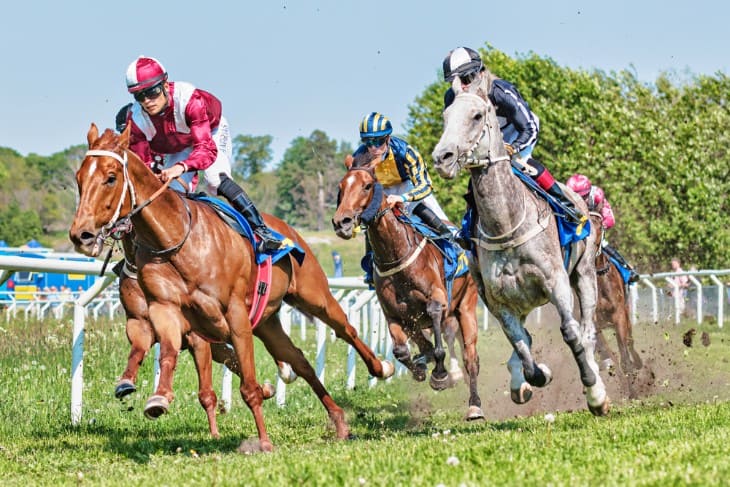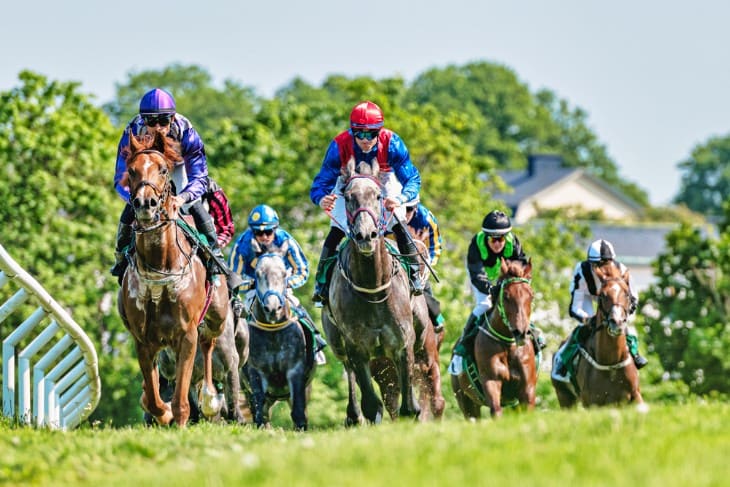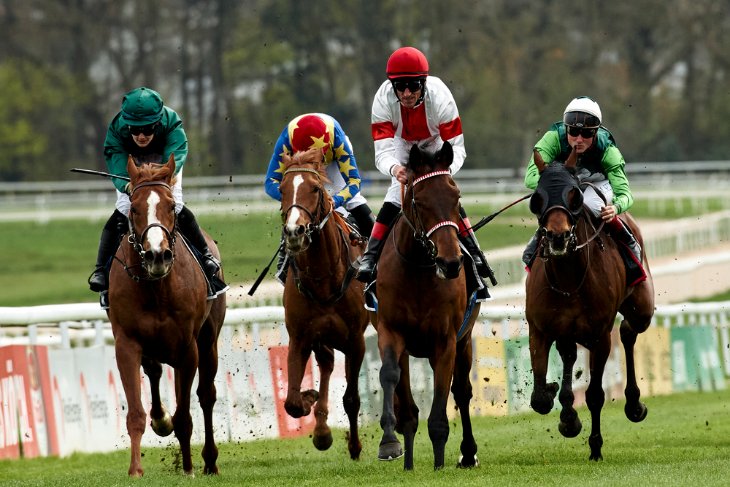- Behind the Rhythm: Unveiling the Pacemaker's Role
- Mastering Strategy; Coordinating with Pacemakers
- Identifying the Trailblazers: Spotting Potential Pacemakers
- The Impact of Pace: Reshaping Race Dynamics
- Tipping the Scales: The Pacemaker's Influence on Race Outcomes
- Ethical Debates and Controversies: Safeguarding the Sport's Integrity
- Legendary Races and Betting Implications: The Pacemaker's Indelible Mark
- Conclusion
Behind the Rhythm: Unveiling the Pacemaker's Role
Pacemakers, also known as 'rabbits' or 'setters,' are horses specifically entered into a race to set a rapid and consistent pace. Their purpose? To prevent the race from becoming a tactical chess match, where jockeys cautiously monitor one another's moves, resulting in a sluggish and uncertain tempo. Instead, the pacemaker's presence ensures a brisk and controlled cadence from the moment the starting gates fling open.
This controlled tempo offers several advantages to the main contender. By maintaining a swift pace, the pacemaker allows the favoured horse to conserve energy for the crucial final stretch. Additionally, it prevents the field from bunching up, giving the main contender ample space to manoeuver and avoid being boxed in by rival runners.
The pacemaker plays a role in races and long distance competitions, where the competition is intense and the stakes are high. Their strategic positioning can determine success or failure as they create a path for the contender to demonstrate their potential.
- In prestigious races like the Kentucky Derby, pacemakers are often employed to ensure a blistering pace, spreading out the field and minimising potential traffic congestion.
- In endurance tests such as the Belmont Stakes, pacemakers are crucial in maintaining a consistent tempo, preventing the race from becoming a tactical affair that could sap the strength of the leading contenders.
- Even in smaller races, the presence of a pacemaker can be a game-changer, as it eliminates the need for the main contender to expend valuable energy in setting the pace.
Mastering Strategy; Coordinating with Pacemakers
Working, with pacemakers involves planning that demands collaboration among trainers, jockeys and owners. The choice to utilise a pacemaker is always an one, involving an evaluation of the leading runners strengths, weaknesses and the tough competition they will encounter on the race track. Trainers play a role in selecting the pacemaker for their horse. They look for a runner with a racing style that matches well able to set the required pace while sustaining endurance throughout the race. In cases trainers will pick a pacemaker from their stable or one familiar with the main runners racing preferences to ensure a smooth partnership that enhances the horse's natural tendencies. Effective communication between the jockey and pacemaker is vital for strategy success. Prior to the race they carefully. Coordinate their tactics based on the pace to be set. The pacemaker must find the right balance. Running enough to keep up with the contender but not too fast that they tire out prematurely before reaching the finish line.
- Trainers often employ unique tactics, such as using a pair of pacemakers, with one setting the initial blistering pace and the other taking over midway through the race.
- In some cases, pacemakers may be instructed to vary the tempo, occasionally accelerating or decelerating to keep the competition guessing and off-balance.
- Strategic positioning on the track is also crucial, as pacemakers can block opponents' paths and limit their options, creating a clear path for the main contender to surge ahead.

Identifying the Trailblazers: Spotting Potential Pacemakers
Choosing the pacemaker is an art form in itself. Trainers carefully analyse the list of participants in a race to pinpoint candidates who can effectively serve this role. A pacemaker must be sturdy, resilient and suited to the race's distance. They should be able to maintain a pace without succumbing to pressure.
Occasionally horses that excel as pacemakers may not possess talent to win prestigious races. Nevertheless their strategic value makes them assets in assisting the contender in their pursuit of victory. These horses often gain a reputation as pacemakers. Earn a place in significant races for years ahead.
- Experienced trainers look for horses with a proven track record of setting a blistering pace and maintaining it throughout the race, even if they lack the closing speed to secure victory.
- Certain bloodlines and breeding programs are known to produce horses with an innate aptitude for pacemaking, guiding trainers in their selections.
- Physical attributes such as stamina, muscular build, and cardiovascular efficiency are also carefully evaluated when identifying potential pacemakers.
The Impact of Pace: Reshaping Race Dynamics
To keep their opponents on edge pacemakers may alter the pace during the race. They might accelerate at times to push the pursuing group to expend energy or decelerate to test their rival's patience. This element of unpredictability injects uncertainty into the race leaving competitors wondering about the move by the pacemaker.
On occasion pacemakers have set such a pace that it causes caused gaps between horses in the field to widen significantly making it extremely challenging for trailing competitors to catch up.
- In some cases, pacemakers have been known to set such a blistering pace that the field becomes stretched out, with gaps of several lengths between horses, making it nearly impossible for the chasing pack to make up ground.
- Pacemakers can also act as strategic blockers, positioning themselves to impede the progress of rival horses, giving the main contender a clear path to victory.
- The psychological impact of a pacemaker's presence cannot be underestimated, as it can unsettle the competition and force them to make hasty, potentially costly decisions.
Tipping the Scales: The Pacemaker's Influence on Race Outcomes
It is not an overstatement to suggest that pacemakers wield influence over race outcomes. When executed skillfully, a pacemaker's presence can create an environment that aligns perfectly with the strengths of the leading contender. By maintaining an swift pace from the start the favoured horse can conserve energy and wait for crucial moments in the race.
The impact of pacemakers is particularly noticeable in races with participants. In races without a designated pacemaker chaos may ensue, with riders competing for positions and resulting in a slow paced tactical event. This scenario could hinder a runner's chances as they might struggle to break away, from the pack and showcase their full capabilities.
- In the 1975 Epsom Derby, the legendary horse Grundy was guided to victory by the pacemaker Bustino, who set a blistering pace that stretched the field and allowed Grundy to surge ahead in the final furlongs.
- In the 1990 Breeders' Cup Mile, the brilliant miler Royal Academy was expertly supported by the pacemaker Mr. Nickerson, whose precise and aggressive running style paved the way for Royal Academy's spectacular win.
- Pacemakers have been known to alter the betting odds dramatically, as the market responds to the perceived advantage of the main contender, potentially creating shorter odds and influencing betting strategies.

Ethical Debates and Controversies: Safeguarding the Sport's Integrity
Pacemakers have indeed brought a twist to horse racing sparking discussions and ethical dilemmas in the racing community. Critics argue that pacemakers disrupt the authenticity of the sport transforming it into a game, rather than a genuine assessment of a horse's natural abilities and expertise.
Some suggest that races should naturally progress, allowing horses and jockeys to demonstrate their skills without influences. They believe that pacemakers disrupt the flow of the race making it more predictable and controlled taking away from the excitement and unpredictability that defines horse racing.
Additional ly concerns have been raised regarding the well being of pacemakers themselves. These horses are entered into races, with the role of setting a pace to support their stablemate or top contender. The physical demands of this position can be strenuous as pacemakers must maintain a tempo often leading to exhaustion and fatigue.
- Critics argue that the strategic use of pacemakers could lead to over-racing and an increased risk of injury, putting the horses' well-being at risk.
- There are concerns about whether pacemakers receive the same level of care and attention as the main contenders, as their primary function is to serve the interests of their stablemate.
- Some believe that the use of pacemakers goes against the principles of fair competition, as it provides an unfair advantage to certain horses and stables.
Proponents, however, counter these arguments by asserting that pacemakers enhance the sport and add a layer of excitement and strategy that captivates audiences. They argue that pacemakers are well-trained athletes, capable of handling the demands of their role and are often well-rewarded for their efforts.
Additionally, pacemakers can contribute to the longevity of a racehorse's career. Horses that might not be competitive at the highest levels can find purpose and success as valuable pacemakers, extending their racing careers and providing entertainment for racing enthusiasts.
Legendary Races and Betting Implications: The Pacemaker's Indelible Mark
In the history of horse racing there have been memorable races where pacemakers played a crucial role in shaping the results and leaving a lasting mark on the sport. One standout example is the Epsom Derby, a race held in England. Back in 1975 an unforgettable moment unfolded when Grundy, a horse with jockey Pat Eddery in the saddle was set to compete in this event. Unexpectedly Grundy's trainer, Peter Walwyn decided to enter another horse from their Bustino to act as the pacemaker.
During the race itself Bustino took off at a speed leading the pack and laying down the groundwork for Grundy's victory. Despite Grundys talent and competitiveness on that day it was ultimately the strategic presence of Bustino as a pacemaker that paved the way for their win – underscoring just how impactful well planned pacemaker strategies can be, in horse racing.
- The 1990 Breeders' Cup Mile at Belmont Park is another memorable race influenced by pacemakers. The brilliant miler, Royal Academy, was expertly guided by his pacemaker, Mr. Nickerson, whose precise and aggressive running style set the race up perfectly for Royal Academy's spectacular win.
- In the 2018 Belmont Stakes, the pacemaker Restoring Hope played a crucial role in Justified's historic Triple Crown victory, ensuring a swift pace that suited the eventual champion's strengths.
- The presence of pacemakers can significantly impact betting strategies, as punters must carefully consider their influence on race dynamics and potential shifts in odds.
The influence of pacemakers, on betting tactics is significant. When races feature pacemakers the betting odds can change drastically reflecting the perceived advantage of the leading contender. Bettors tend to lean towards horses that benefit from support from a pacemaker possibly resulting in odds for these top contenders.
Nevertheless, success with a pacemaker strategy is not always assured. Various factors such as the pacemaker's performance, the jockeys execution of the plan and how competitors react can all affect the outcome. Therefore, wagering on races, with pacemakers demands an understanding of the complexities involved, necessitating punters to meticulously assess the form and track record of all participating horses.
Conclusion
In the paced world of horse racing, where fortunes can change in an instant the pacemaker plays a role, as a key strategist guiding the race's pace and direction. Often overlooked compared to the jockey's and horses, these unsung heroes significantly influence race dynamics and outcomes, captivating spectators with their prowess.
From their selection process to the execution of strategic moves, pacemakers exemplify meticulous planning and accuracy. Their presence adds an element of suspense and thrill to the sport pushing the boundaries of play while showcasing what can be achieved on the racetrack.








